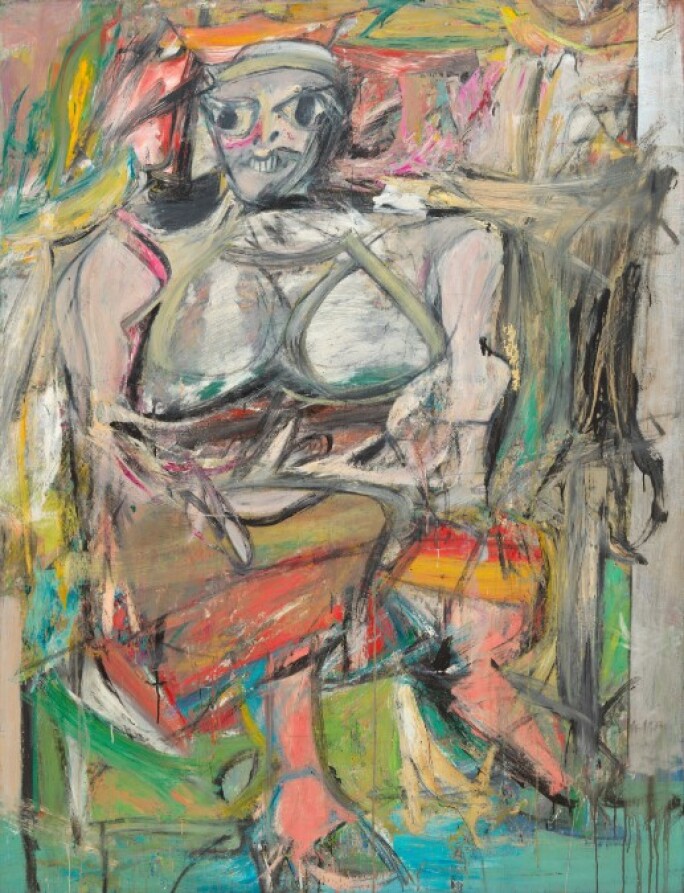O
ften portraying allegorical matter in mysterious and thrilling scenery, Dana Schutz’s canvases capture complex chronicles of contemporary life, and engage the viewer's psychological senses through their capacity to viscerally portray subjective experience. Illustrating fairy tale tropes with expressionistic bravado, Eye Eater is a captivating example from the artist's revered series of Self Eaters which both allure and disturb in their surreal, whimsical depictions. A macabre, fantastical scene executed with a paradoxical cacophony of resplendent color, the work portrays an entrancing narrative dystopia: beams of light trickle through a forest canopy, illuminating a blotchy figure crouched low to the ground with an eyeball in hand in an apparent act of self-affliction. Rendered in short, rapid brushstrokes and an incongruous palette featuring fleshy pink, bright green, and yellow, the painting articulates the unease that epitomizes the artist’s acclaimed comic-grotesque vision.
"Schutz loves to give her characters life and then cut them up. Yet hers is a blithe cruelty, the curiosity of a child playing at being a creator. Even when she hates, she does it with whimsy... Her work is sadistic but not sinister, witty but not acid, and free of grown-up vengeance. Often, her most graphic images are her most cheerful. The Self-Eaters series, for instance, are not portraits of men and women consumed with self-loathing. Rather, they are Schutz’s vision of a self-sufficient race—they eat themselves, and rebuild themselves..."

Complicating Schutz's allusions to a futuristic humanoid race, her figures' recurrent wild existence—often portrayed in verdant jungles—points towards something more primal, as if to remark the ongoing absurdity of our species. Though profoundly imaginative, her metanarratives are rooted in present realities, on societies whose norms when closely examined devolve into the repugnant. The figure in Eye Eater is contorted and unevenly patterned as if to reflect this decay and destruction—at once recalling Francisco de Goya, Edgar Allen Poe, and Willem De Kooning's violent Women. De Kooning himself famously said, “Beauty becomes petulant to me. I like the grotesque. It’s more joyous.” Schutz is without question the 21st century inheritor of this idea, creating a sense of hope amidst her unblinking gaze into the unpleasant truths that abound in everyday life. Her self-cannibalizing characters, therefore, help the artist explore meaning-making in a world of self-consumption for the sake of regeneration. Speaking to the Self Eaters series, Schutz has said:
“… The Self-Eaters began privately as drawings that I was afraid would seem super angsty, like bad therapy or really embarrassing expressionism, but I became interested in the way they could open up into a situation. If you took death out of the equation, they could eat themselves and then remake themselves to be any form they wanted to be. In this case the subject was a site—something that constantly produced and consumed itself. I felt like it could relate to painting, since there was so much recycling going on, but also other systems in the world.”
The focus on eye infliction in Eye Eater evokes a long history of its archetypal use, conjuring the Brothers Grimm version of Cinderella whereby her eyes are pecked out by birds, or Oedipus' act of self-blinding after learning that he had married his mother and killed his own father. In the present work, besides the eye in the sitter's hand, two perfectly spherical additional eyes rock gently on the ground nearby. Having come to rest neatly on a circular patch of sunshine, perfectly spaced from each other, these two yet-to-be-eaten eyes immediately call to mind Carlo Crivelli’s altarpiece of Saint Lucy, who preferred to gouge out her own eyes than be taken by a suitor. Rather than ending her narratives with the classic resolution of pure tragedy, however, Schutz's Self Eaters carry optimism through the possibility for rebirth and renewal. Therefore, eyes are eaten perhaps for what they have seen, making the present scene become one of recycling and transformation so as to lead to a new vision of reality.

"I’m probably more interested in science fiction than other forms of fantasy. I like the sense of place or history that can mirror social realities and events and anxieties. I like Animal Farm, superheroes and mix-ups at the lab, disaster films, and practically anything about epidemics... However, it is really important that the paintings do not hole up in their own realm of fantasy. I want the paintings to take into account what’s going on outside them."
Born in 1976, Schutz came to prominence in the early 2000s for her dark humour, allusions to art history and provocative subject matter. Known for her “inventive and muscular way of shaping space on canvas to build what her friend, the painter Cecily Brown, called ‘bulletproof constructions’,” Schutz’s bold, surreal figurations comment on pop culture, mythic figures and charged contemporary issues whilst drawing from a deep mine of art historical references encompassing Synthetic Cubism, German Expressionism, CoBrA, Masaccio, and Courbet, amongst others (Ted Loos, “After the Quake, Dana Schutz Gets Back to Work”, The New York Times, 9 January 2019). The resulting concoction is utterly engrossing even as it perplexes or even repels, rendering the deep anxieties of contemporary life with searing ability. As Peter Schjeldahl observes: “Though her style can suggest Expressionism, it is detached from mere personal emotion. She objectifies anxious states of mind – or of soul” (Peter Schjeldahl, “Dana Schutz”, The New Yorker, online). Schjeldahl also writes: “Schutz creates allegories of uncertain but torrid, gnashing implication, a bit like the enigmatic narratives of the German modern master Max Beckmann, but less solemn. She does this with almost preposterously extraordinary gifts for composition, paint handling, and, in particular, color, suffusing clashes of hue and tone with ghostly essences of a chromatic unity that you feel rather than quite see” (Ibid).
Recently the subject of a major mid-career survey organized by the Louisiana Museum of Art in Humlebaek, Denmark and the Musée d'art moderne de la ville de Paris, Schutz is recognized as one of the most important visual storytellers of her generation.



